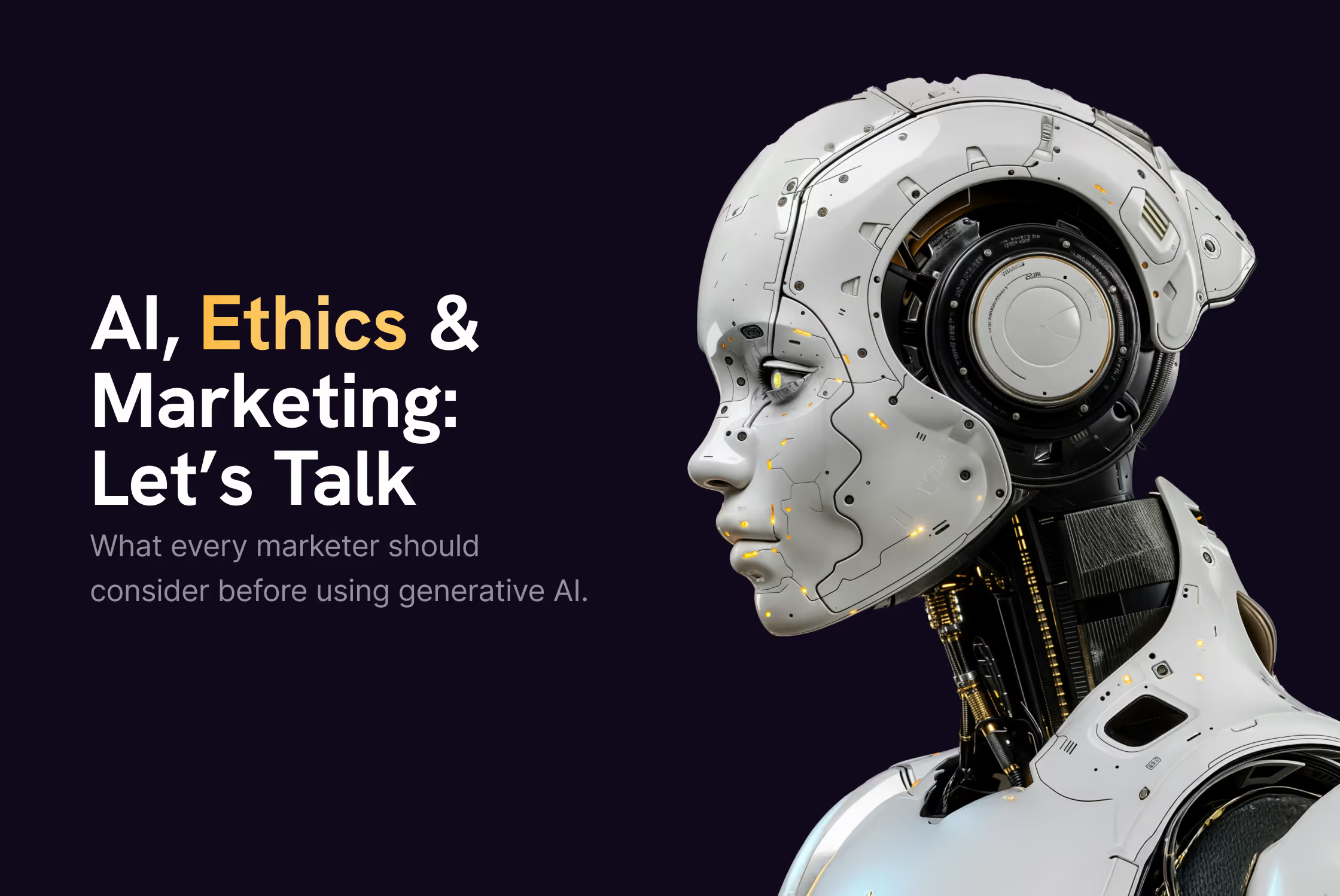Can You Use AI in Marketing... and Still Be Ethical?


In the ever-evolving marketing communications landscape, Generative Artificial Intelligence (AI) tools are becoming increasingly more present in our daily landscape. From personalised content development to advanced analytics, AI can significantly enhance the efficiency and effectiveness of marketing strategies. However, with great power comes great responsibility, and ethical considerations must be at the forefront of AI implementation.
The ethical use of AI in marketing hinges on transparency, data privacy, bias mitigation, and consumer empowerment. Businesses should clearly disclose their use of AI, protect customer data, and use AI as an aid.
Transparency is Key.
One of the fundamental principles of the ethical use of Generative AI in marketing is transparency. Businesses should be open and transparent about using AI tools internally and externally. Customers have the right to know when AI is employed in creating content, analysing data, or any other aspect of marketing communication.Communicating the role of AI not only builds trust but also empowers consumers to make informed choices.

Data Privacy and Security.
In the era of big data, where AI tools thrive on extensive datasets, safeguarding customer information is paramount. To uphold ethical standards, businesses should adopt robust data protection measures, ensuring that customer privacy is a top priority. Compliance with data protection regulations, such as GDPR, and obtaining explicit consent for data usage is a proactive step.
An additional layer of ethical responsibility involves anonymising and encrypting customer data. This protects individuals from potential misuse and safeguards the reputation of businesses. By adopting cutting-edge technologies and practices in data security, companies can demonstrate their commitment to ethical conduct in the AI-driven marketing landscape.

Bias Mitigation.
Addressing the unintentional biases inherent in AI algorithms requires continuous effort and vigilance. In marketing communications, businesses must proactively identify and rectify biases in their AI systems. Regular audits, coupled with diversity considerations during the training phase, become essential tools in the fight against discrimination and stereotype reinforcement.
To take this a step further, businesses can collaborate with external organisations or hire third-party auditors to assess the fairness of their AI algorithms. By embracing diversity in the development and testing phases, businesses mitigate biases and ensure that their AI tools resonate with a broad and varied audience.

Empowering, Not Manipulating.
While AI has the potential to revolutionise personalisation, businesses must approach this capability with ethical considerations in mind. Beyond tailoring content to individual preferences, companies must avoid exploiting emotions or vulnerabilities for manipulative purposes. Ethical marketing communication with AI should be designed to empower and educate consumers, fostering a sense of autonomy and informed decision-making.
To achieve this, businesses can incorporate transparency into their personalisation strategies, informing consumers about the criteria and algorithms used to tailor content. By emphasising user control and choice, companies build trust and position themselves as ethical leaders in AI-driven marketing.

Accessibility and Inclusivity.
Ensuring that AI-driven marketing strategies are accessible is a fundamental ethical imperative. Businesses should strive to design AI tools with inclusivity in mind, considering factors such as disability and socioeconomic status. This commitment to inclusivity aligns with ethical standards and amplifies AI’s positive impact on marketing communications.
Practical steps can include:
- conducting accessibility audits to identify potential barriers,
- actively seeking input from diverse user groups during the development phase
- providing alternative formats for content to cater to different needs.
By embracing inclusivity, businesses broaden their audience reach and contribute to a more equitable and ethical digital landscape.

Continuous Monitoring and Adaptation.
The ethical considerations surrounding AI are dynamic and necessitate ongoing vigilance. Businesses must commit to continuous monitoring and adaptation of their AI strategies to align with emerging ethical standards. Staying informed about industry best practices, legal developments, and societal expectations ensures businesses can adjust their AI strategies accordingly.
Regular assessments of the impact of AI tools on marketing communications should be integrated into standard business practices. This may involve establishing an internal ethics committee or collaborating with external experts to provide insights and recommendations. By prioritising continuous improvement, businesses can demonstrate their dedication to ethical AI use and contribute to the responsible evolution of marketing communication practices.

Conclusion.
The ethical use of AI tools in marketing communications demands a multifaceted commitment. Transparency, data responsibility, bias mitigation, and a focus on empowering consumers should not be viewed as standalone principles but as interconnected elements that collectively shape ethical conduct. By prioritising these considerations, businesses can harness AI’s power to enhance efficiency and create more meaningful and responsible connections with their audiences in an ever-evolving digital landscape.

Afterword.
*THE CONTENT ABOVE WAS WRITTEN USING CHATGPT*
I’ve always been intrigued by the ethical considerations surrounding using artificial intelligence (AI) in various industries. Wondering what an AI would “think” about these ethical dilemmas, I decided to experiment.
Curiosity led me to test ChatGPT, an AI language model. I initially gave it a simple prompt, “Please write an article about the ethical use of AI tools for marketing communications,” and set the digital pen in motion. The initial output was insightful but somewhat superficial.
I then asked ChatGPT to delve deeper, to add substance and nuance to its initial insights.
It responded by expanding on each section of the article. Yet, despite its impressive data analysis capabilities, the writing still lacked the distinctive touch that would make it unmistakably mine. Should this have been anything other than a test, a writer would need to take on the role of an editor, adjusting the text, rephrasing, and infusing it with their style.
This experience affirmed that ChatGPT is an invaluable tool, offering a solid foundation to build content. It effectively jumpstarts the creative process, providing information and insights. While some manual adjustments were necessary, this experiment is a testament to the synergistic potential between human creativity and AI capabilities.
Curious about whether the effectiveness of ChatGPT lies in the construction of its prompts, I provided a specific mandate: “Act like an expert marketing copywriter and rephrase the article into a ready-to-publish content piece.“
The outcome was pleasantly surprising. Although it appeared somewhat excessive in “marketing fluff” for my taste, the shift in writing style was obvious. It made me think of the potential for future developments in ChatGPT-like models—a prospect where an AI language model could adeptly emulate individual writing styles.
As the technology evolves, the ability to customize and fine-tune the AI’s output to match a preferred personal style could be a transformative feature. Currently, ChatGPT only allows limited custom instructions for your account, which take effect in all your dialogues with the AI.









